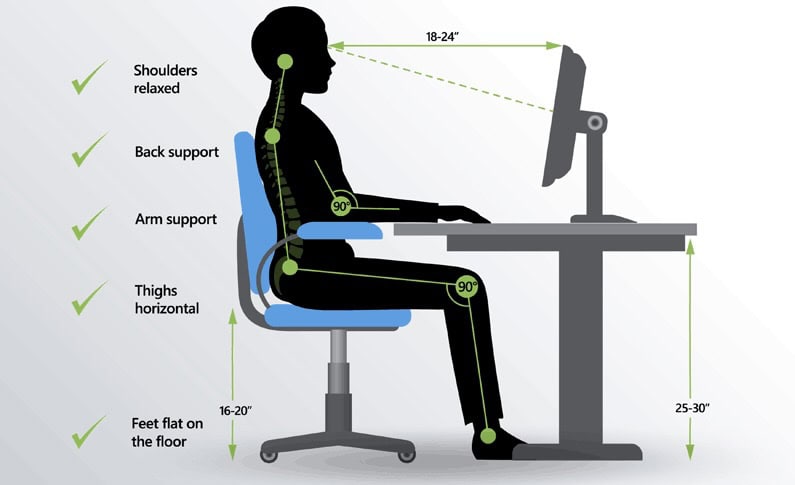Neck pain is a common condition, particularly in office workers when compared to other occupations. It was found in a study by Chen et al., 2018 that approximately 42% to 63% of office workers suffer from neck pain. This is a fairly high number, and not only does having pain and discomfort affect our job, but it can also affect our life outside of work.
It is likely that your workplace has provided education or strategies for your specific job and job environment such as ergonomics tips. This may have included proper desk set up, sitting posture, limiting screen time, chair adjustments, or standing breaks every so often. These can be helpful but may not be enough to reduce or prevent your neck pain. More specifically, these techniques may provide some relief, but often once the neck pain has developed it turns into a reoccurring issue.
Why do office workers get neck pain?
There is likely many contributing factors to your neck pain including physical, psychological and environmental factors. As you may know, office workers sit for prolonged periods of time at their desk or computer. Remaining in a seated position for a prolonged time can cause muscles to fatigue, resulting in a bent over posture and forward head position. Repeating this day-to-day can cause compression through our neck and overstretching of specific neck muscles, and eventually turn into neck pain. Further, these overstretched neck muscles may eventually reduce in endurance and strength, which can exacerbate the problem. These specific neck muscles are in place to support our head, help with posture and provide stabilization to our neck – therefore, if they are weak and lack endurance our body will rely on other structures to support our head and neck causing neck pain and tightness.
What does the research say for office workers suffering from neck pain?
If the previously mentioned tips and strategies provided by your workplace are not enough, then what else do we do? The study by Chen et al., 2018 investigated different workplace-based
interventions for the prevention, management and reduction neck pain in office workers – let’s
see what they found.
Office workers who have neck pain benefited from specific neck and shoulder strengthening exercises. More specifically, the individuals who were symptomatic with their neck had the greatest reduction in neck pain intensity. Also, the researchers suggested that even those not suffering from neck pain, but are at an increased risk due to the nature of their job, may benefit from a neck and shoulder exercise program.
The type of neck and shoulder exercise vary from stretching the muscles around the area,
building up strength and increasing endurance in surrounding musculature. For example, an
exercise program consisting of front raises, lateral raises, reverse flies, shrugs, and wrist
extensions was shown to be beneficial for reducing neck pain in office workers.
How can physiotherapy treatment help office workers suffering from neck pain?
A guided and well-balanced neck and shoulder strengthening program is a great start for neck
pain. A physiotherapist can help provide you with specific exercises and an appropriate intensity for your level of fitness. Along with these types of exercises, physiotherapy interventions such as manual therapy to loosen and stretch muscles surrounding the neck may be beneficial. Also, the use of modalities such as acupuncture may help to speed up your recovery and reduce your neck pain even more.
What are some tips and strategies from a physiotherapist’s perspective?
1.Practice good posture: you may recall people telling you to straighten up and “fix” your
posture – but what does this exactly mean, and what is an optimal posture? Recent evidence states there is no optimal posture, but that holding a position for a length of time (i.e. >20
minutes may cause discomfort. Therefore, frequently changing our posture, such as standing up, stretching out our arms or walking is beneficial.
2.Alter your workstation: your workplace may have signs up or given tips to set up your office
space for better comfort. Follow the below picture for a good starting point on how to set up your office space.

3.Increase your activity throughout the day: being busy with work and sitting for the majority of our day is likely contributing to our neck pain. Therefore, finding time before work, after work or even on our lunch breaks to be active is important. For example, going for a 30-minute walk before work can be beneficial for our musculoskeletal and cardiovascular systems.

Neck pain can have a large effect on our work productivity, mood, and general life outside of work. If you are tired of suffering from neck pain or discomfort and looking to improve yourself, visit South Simcoe Physiotherapy at our Alliston or Tottenham locations. One of our physiotherapists will take you through a physical examination to identify the exact problem, as well as prescribe specific exercises and treatments to help reduce your neck pain.
Workplace-Based Interventions for Neck Pain in Office Workers: Systematic Review and Meta-Analysis
Xiaoqi Chen, Brooke K Coombes, Gisela Sjøgaard, Deokhoon Jun, Shaun O’Leary, Venerina Johnston
